Menu
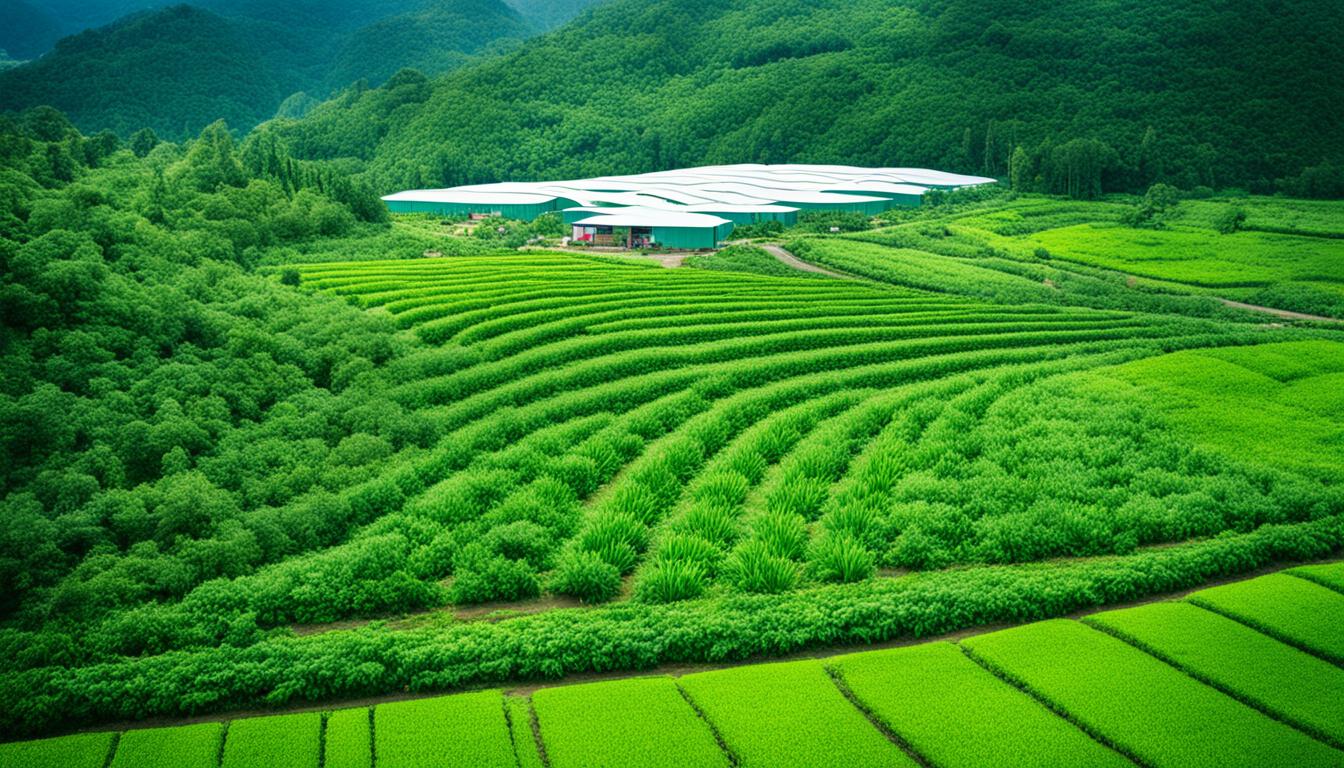
Did you know that livestock makes up 40% of the world’s agricultural value? It’s crucial for the livelihoods of 1.3 billion and their food security. The World Bank plays a big role in pushing for sustainable farming systems. It focuses on Climate-Smart Agriculture (CSA) to see more output, stronger farms, and fewer emissions. Yet, the sector emits 7.1 gigatonnes of CO2 a year, about 14.5% of all human CO2.
Investment in agriculture to cut down emissions is low. But, the World Bank’s Climate Change Action Plan from 2021-2025 is changing this. It will pour nearly $3 billion a year into green agriculture. This money will be used to make sure new projects help reach the Paris Agreement’s goals.
The World Bank is using clever tools to push for eco-friendly farming. Tools like Country Climate and Development Reports and Climate-Smart Agriculture Country Profiles help. They want to set high global sustainable farming standards. And make sure countries put these rules into practice.
Sustainable farming is vital to meet food demands and tackle environmental problems. The current way we farm adds a lot to the planet’s issues. With more people coming, we need to make sure we grow food without making the climate worse.
Today, farming systems cause a lot of methane and lead to plants and animals disappearing. These systems also use most of the fresh water we have. To make things worse, throwing food away creates a lot of pollution. This shows that we urgently need better farming methods. The old ways of farming led to too much use of land and resources. This makes our environmental problems even bigger.
Farming needs to change to help our planet and feed everyone. We can farm in ways that protect our environment. These methods should support both the growing need for food and save our planet’s ecosystems.
Problems are more severe in poorer countries, where farm emissions are growing fast. Yet, funds to help these areas are very low. Only 4% of money to fight climate change goes to farms. Of that, small farmers only get one-fifth. Efforts are being made to change this. The World Bank is now spending nearly $3 billion a year on Climate-smart Agriculture. This is part of a global plan for climate action from 2021 to 2025. By supporting agriculture, water, and land projects, it aims to meet the Paris Agreement’s goals.
Several plans and actions are helping make farming more sustainable. These include Country Climate and Development Reports (CCDRs) and Climate-Smart Agriculture Investment Plans (CSAIPs). Countries like China and regions in Africa are working on green farming projects. These efforts show a worldwide promise to farm in ways that protect our environment.
Handling the challenges of sustainable agriculture is crucial today. Food security problems and environmental impacts are growing. The agrifood system causes about one-third of all global emissions. It also uses 70% of the world’s fresh water. Plus, food waste is a top emitter of greenhouse gases worldwide.
Climate change is severely affecting food security worldwide. Changes in weather essential for farming are messing up food supplies. This is a big issue, especially for developing countries. Emissions from agriculture in these places keep rising, affecting the planet more. To help, the World Bank is putting more money into Climate-Smart Agriculture (CSA). They’ve increased their funding to nearly $3 billion every year. Still, only a small amount of the money to fight climate change goes to the food sector. Small farmers benefit even less.
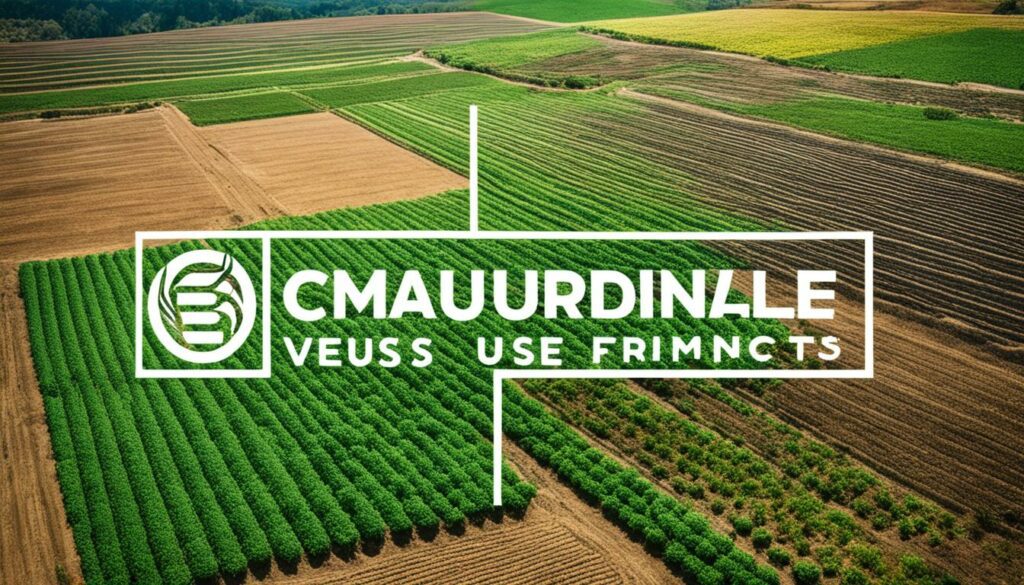
Today’s farming ways are bad for the environment. They lead to a lot of greenhouse gas emissions and loss of biodiversity. The livestock industry alone produces 7.1 GT of CO2 each year. This is almost 15% of all human-made greenhouse gases. The World Bank is supporting various agriculture projects to help. For example, they have a program in Africa to make food systems stronger. And in Pakistan, they are working on using water in agriculture more efficiently.
To make agriculture more sustainable, we need better farming policies. For example, in Mexico, switching to green energy saved over 3 million tons of CO2. In Uruguay, focusing on better waste management in dairy farming is showing good results. It proves that by working on how we use the land and water, and by making smart choices using technology, we can farm in a way that protects the environment. This ensures we have enough food in the long run.
| Country | Project Focus | Impact |
|---|---|---|
| Mexico | Environmentally sustainable energy technologies | Reduction of 3,388,670 tons of CO2 emissions by 1,165 agribusinesses |
| Uruguay | Improved effluent management in dairy farms | Sustainable soil management, water conservation, digital technology for improved decision-making |
| Vietnam | Livestock farming strategies | Benefited over 151,000 farmers, reducing negative environmental impacts |
| Colombia | Silvopastoral systems | Captured 1.05 million tons of CO2, increased milk production by 17%, reduced costs by 18.5% |
It’s clear: we must act to reduce the harm agriculture causes to our environment. By using the right policies and sustainable methods, we can protect our earth. This way, we make sure there’s enough food for the generations to come.
The World Bank is fully committed to making agriculture sustainable. It has launched several key projects and made big investments. Since one-third of all emissions come from food systems, we need to act now. These systems also use 70% of the world’s fresh water. With the world’s population likely to reach 9.7 billion by 2050, it’s clear why we must make agriculture sustainable.
The Bank’s focus has been on boosting Climate-Smart Agriculture (CSA), increasing support to almost $3 billion a year. This huge increase shows the Bank’s serious about sustainable farming. It aims to make farming more productive, resilient, and less polluting with these investments.
Despite being key to climate change solutions, global farming only gets 4% of climate funding. And, just one-fifth of that goes to small farmers. To change this, the Bank now ensures its farming projects follow the Paris Agreement goals. This helps its projects fight climate change better.
The Bank’s plan to fight climate change focuses on farming, food, water, and land. It aims to help meet the goals of the Paris Agreement. This means making farming better for the planet.
In Jordan, the Bank is helping 30,000 farms with climate-smart and water-saving methods. Also, in Pakistan, a $200 million project aims to use water more efficiently in farming. These efforts are part of the Bank’s larger push for sustainable farming.
“Our investment in sustainable agriculture is not just about increasing productivity; it’s about ensuring our food systems are resilient and climate-smart,” remarked a World Bank spokesperson.
| Country | Project | Investment | Outcome |
|---|---|---|---|
| Jordan | Agriculture Resilience and Innovation | $200 million | Support for 30,000 farming households |
| Pakistan | Punjab Agriculture Transformation | $200 million | Increased agricultural output per water unit |
| Kazakhstan | Sustainable Livestock Development Program | Varied | Increased beef production, reduced GHG emissions |
There’s also a big push for better livestock management. In Kazakhstan, a project aims to make more beef with less pollution. This work is vital for nearly 1.3 billion people and 40% of the world’s agriculture value.
Projects in Jordan, Pakistan, and Kazakhstan are key for the Bank’s plan. By tackling climate change in farming, the Bank is promoting better use of resources. This supports higher yields and resilience in the face of climate problems.
The World Bank sets rules to help farms become more successful, friendly to the planet, and good for society. These rules touch on many farming activities, from growing crops to caring for animals. They also include ways to save water and protect forests. The aim is to help farms not just make money, but do so in a way that’s kind to the environment.
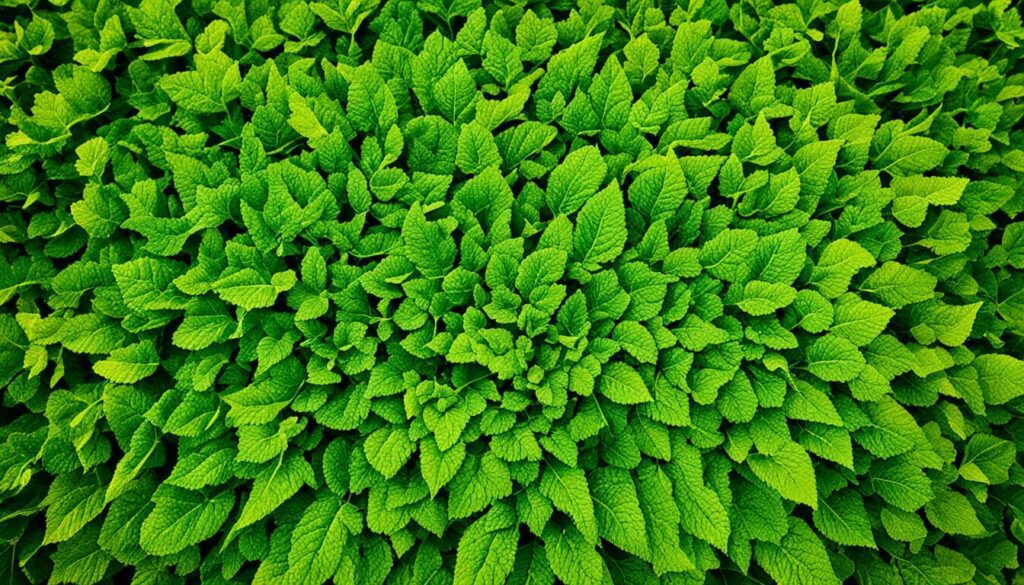
These rules cover a lot, including how we raise animals. Animals provide a huge amount of food and income for people around the world. Yet, they also make a lot of the gases that cause climate change. So, the rules on farming help find a balance. They make sure raising animals is good for the economy and the planet.
Looking at the big picture, farming and food systems globally cause a lot of pollution. To tackle this, the World Bank puts in tough rules. It aims for all new farms to be as green as possible. This means they help more, pollute less, and follow the Paris Agreement’s climate goals.
Putting these rules into action worldwide is a big job. It involves checking if farming projects can handle climate change and disasters. They also keep a close eye on how much gas farms make that harms the planet. Take the work happening in Uruguay, for example. Dairy farms there are getting better at managing waste. This helps them stick to the planet-friendly rules.
The World Bank also helps many projects thrive, from small to big. In places like Bolivia, over 2,600 groups are working together to farm smart. And in Colombia, huge efforts like planting trees on farmland are trapping a lot of harmful gas. Since 2011, these efforts have grabbed 1.05 million tonnes of gas from the air. These efforts show how farming can be good for producing food and caring for the planet.
| Country | Project | Outcome |
|---|---|---|
| Mexico | Sustainable Energy Technologies in Agribusinesses | Reduction of 3,388,670 tons CO2 emissions in 2016 |
| Uruguay | Sustainable Dairy Plans | Improved management systems on 500 out of 1,200 dairy farms |
| Colombia | Silvopastoral Systems | Converted 32,000 hectares, capturing 1.05 million tons of CO2 |
Diverse case studies around the world highlight the success of implementing World Bank sustainable farming rules. They show how specific actions and funding can greatly benefit the environment and economy. These examples are a blueprint for the global effort to enhance our food systems.
China, with support from the World Bank, runs a Green Agricultural Program that stands out for its sustainable practices. It focuses on cutting greenhouse gas emissions and caring for the environment. By combining modern farming with eco-friendly methods, it boosts farming efficiency and sustainability. These efforts in China support the World Bank’s overarching aim to develop a food system that protects the environment.
There’s also a strong focus on improving food resilience in Africa, particularly Eastern Africa. The World Bank is working to make food systems more resistant to climate and economic issues. It invests in smart farming practices, helping small farmers adapt to a changing climate while making their lives better. This work is key for local food security and the worldwide fight against climate change.
| Region | Implementation Focus | Outcomes |
|---|---|---|
| China | Green Agricultural Practices | GHG reduction, enhanced productivity |
| Eastern Africa | Food Systems Resilience | Increased resilience, climate-smart technologies adoption |
The agrifood system is a big source of greenhouse gas emissions, making up one-third of all emissions. With 9.7 billion people expected by 2050, we must change. Climate-Smart Agriculture (CSA) helps by using methods that fight climate change, make farms stronger, and increase what they produce.
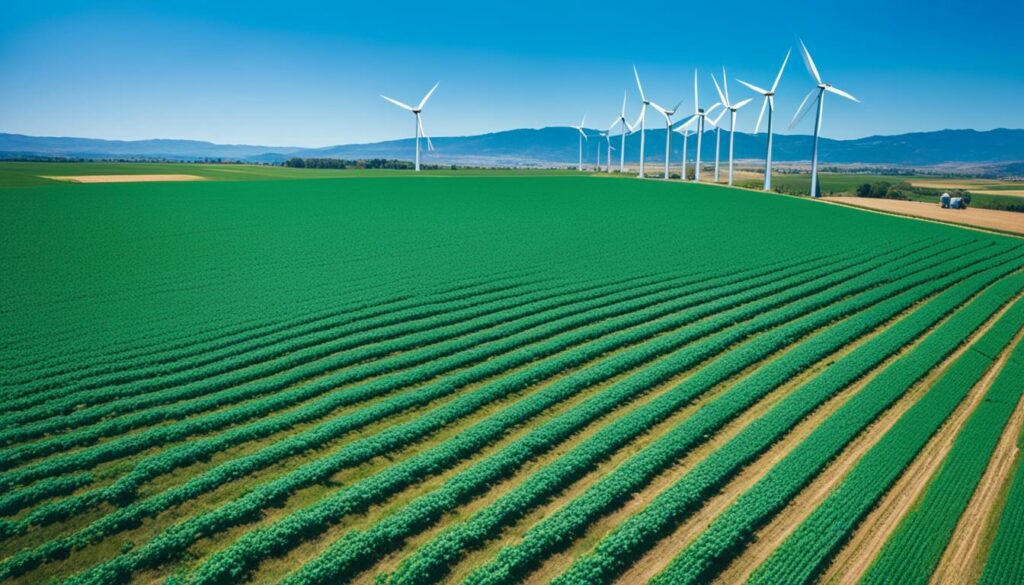
Climate-smart agriculture focuses on farming that cares about the climate. It includes:
The World Bank is putting nearly $3 billion each year into CSA. This money funds projects that make farms better at coping with climate and reduce harmful emissions.
Climate-smart farming uses many practices and technologies:
| Practice | Description | Impact |
|---|---|---|
| Climate-Resilient Crop Varieties | Choosing crops that can take harsh weather. | This keeps food production steady and safe. |
| Conservation Agriculture | Farming methods that protect soil without harming it. | This stops soil from being worn away and helps it stay healthy. |
| Precision Farming | Using high-tech to place fertilisers and water right where it’s needed. | This means using less and getting more from the land. |
| Enhanced Water Management | Getting better at using water and using methods that save it. | This cuts down on water waste and makes farms tougher against dry spells. |
| Improved Livestock Management | Feeding and looking after animals in smarter ways. | This lowers greenhouse gases and makes animal farming more efficient. |
These farming methods help the environment and boost the farm’s income. By making CSA part of national farming plans, as the World Bank suggests, we can fight climate change and feed everyone.
The world’s food production system causes a big part of global emissions. This makes better environmental regulations for farming really important. With the number of people expected to reach 9.7 billion by 2050, we must grow more food. Yet, we also need to lessen the harm to our planet. So, we’re working on rules to cut down on harmful gases, and use water better in farms.
Methane is a strong gas that heats up our planet. It mainly comes from farm animals and their waste. The World Bank is helping by teaching farmers to feed animals better. They also help keep land healthy and use special ways to turn waste into energy. This work helps the whole world fight climate change by limiting how much harmful gas we make.
Farming uses most of the water we have. But we need to use it in a way that lasts. This means making sure to water crops smarter, planting things that don’t need a lot of water, and saving water. These steps help farms make more food without using too much water. They also make farming better able to handle not having enough water during dry times.
| Focus Areas | Key Statistics | World Bank Programmes |
|---|---|---|
| Environmental Regulations for Farming | Emits one-third of all emissions | Climate-smart Agriculture (CSA) Country Profiles |
| Methane Emissions Reduction | Significant to GHG reduction | China Green Agricultural and Rural Revitalisation Program |
| Sustainable Water Management in Agriculture | 70% of fresh water use | Punjab Resilient and Inclusive Agriculture Transformation Project (PRIAT) |
Agroforestry mixes farming with forestry to make land use more diverse. It’s great for the environment, especially when we think about how much the agrifood system pollutes. This way of farming is key as we work to feed over 9.7 billion people by 2050.
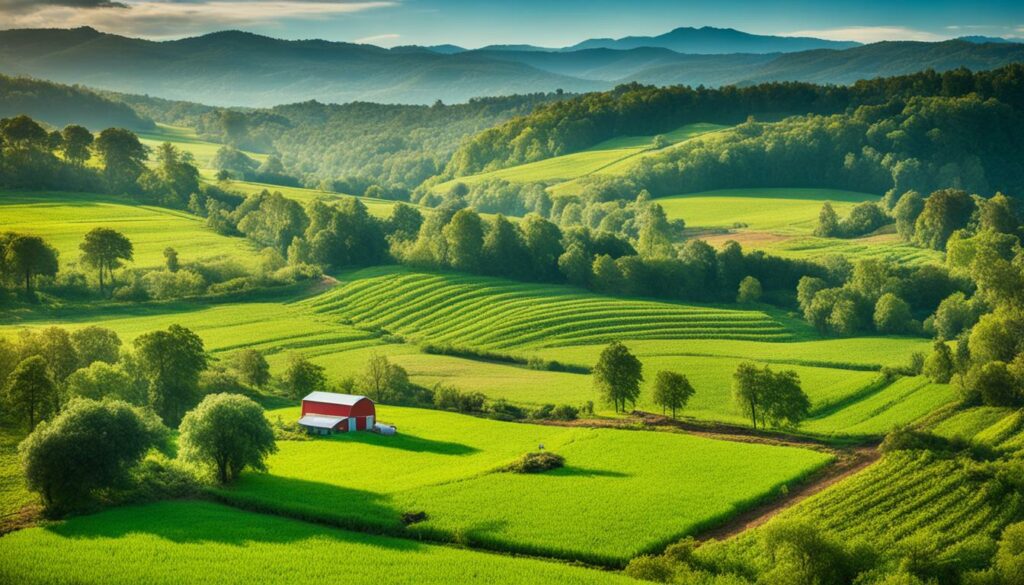
Agroforestry brings many good things, fitting well with sustainable farming. It:
The World Bank puts a lot of money into projects that blend farming and forestry. It’s part of their big effort to support farming that’s good for the planet, aiming to spend almost $3 billion yearly.
The Bank’s big agroforestry projects include:
| Project | Region | Focus |
|---|---|---|
| China Green Agricultural and Rural Revitalization Program | China | It focuses on eco-friendly farming and cutting down on greenhouse gas emissions. |
| Food Systems Resilience Program for Eastern and Southern Africa | Africa | It helps farmers use climate-smart technology. |
| Punjab Resilient and Inclusive Agriculture Transformation Project | Pakistan | It makes better use of water and supports sustainable farming. |
| Agriculture Resilience, Value Chain Development and Innovation (ARDI) program | Sub-Saharan Africa | It strengthens farming chains and increases resilience. |
From July 2023, all World Bank projects must support the goals of the Paris Agreement. This shows their deep commitment to cut down on emissions and push for sustainable practices. Their focus on agroforestry helps fight deforestation and boosts farming too.
The World Bank has helped a lot in developing countries. It has boosted farm productivity and made them more able to deal with bad weather and money problems.
The World Bank’s work has really helped to grow more food. In Benin, they taught over 300,000 farmers new ways to grow crops better. This led to more cashews, maize, rice, and pineapples.
In Burkina Faso, thanks to the Bank, there was more meat and eggs. Production went up by almost 7% for meat, nearly 12% for eggs. They also sold 45% more than before.
Also, in the Central African Republic, they increased local food production a lot. It went from 28,000 tons to 73,000 tons. In Ethiopia, nearly a million jobs were created. Farmers there now use better tools and ways to grow food.
The Bank focuses on helping small farmers a lot. It has given them better tools and ways to grow food. This helps them when the weather is bad and when money is tight. For example, in Guinea, a project helped 149,000 farmers. It made them grow 30% more rice and maize. They also sold 42% more.
In Haiti, the Bank’s project made it easier for small farmers to sell their goods. This helped almost 80,000 farmers. In Bolivia, over 2,600 groups of farmers were formed. This helped over 100,000 families.
These special projects show the World Bank makes a big difference. They show how important it is to help small farmers. These big and steady aids can make a world of difference in how much food the world grows.
Switching to sustainable farming needs a lot of money, especially now with global warming. The World Bank sees the need and is keen on backing climate-smart farming and new ideas.
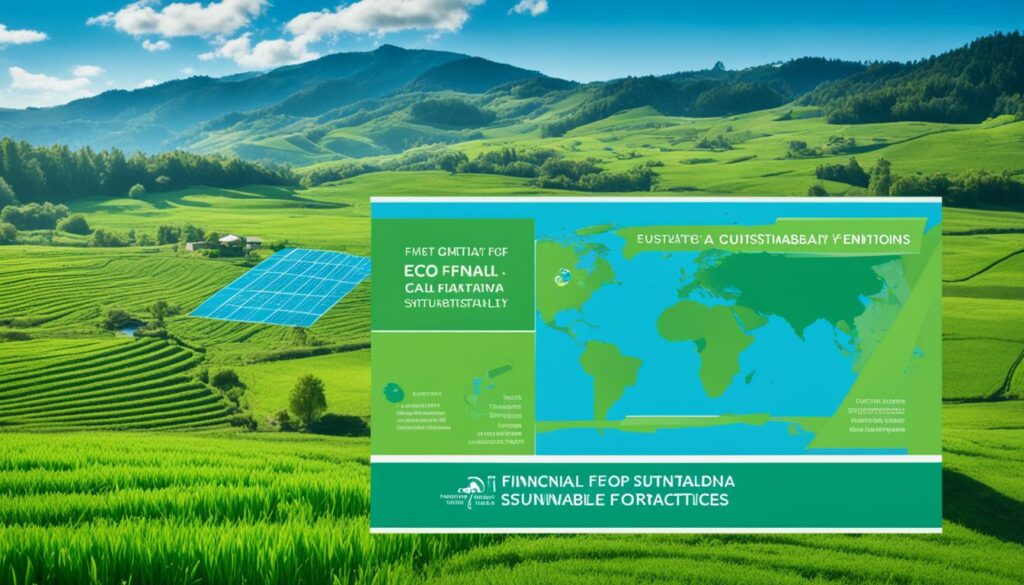
Did you know, the costs hidden in the food industry hit £12 trillion yearly? Yet, the £600 billion given in aid mostly helps big farmers and hurts the environment even more. Redirecting this support towards sustainable methods is key. Funding for climate-smart farming from the World Bank helps tackle these problems and backs smaller, usually left out farmers.
Sticking with old farming ways is often because new tech feels risky to businesses. The World Bank wants to change this by focusing on backing innovative solutions. Country leaders can help by changing what gets financial help. This change would stop bonuses for high emissions and too much sugar, making sure there’s more safe and enough food for everyone. Such a plan helps sustainable farming grow, making sure our food systems are dependable and efficient worldwide.
Policy reforms and national agricultural strategies are key. They help connect global farming with the Paris Agreement. It’s vital to change policies to help both the planet and food safety.
The World Bank pushes for alignment with the Paris Agreement in agriculture. It works hard to make future farming and food ways less polluting. The Bank gives advice and checks on progress to meet green goals.
Supporting the change towards sustainable farming is very important. The World Bank helps countries with their farming plans. These plans aim to grow better while polluting less. They put green farming at the heart of national goals.
Here’s a look at some facts:
| Investment | Details |
|---|---|
| The Natural Gas Market Framework (NGMF) | May get $21 billion from private companies in Iraq. |
| EU Support | Offers $9.5 million for making Iraq’s gas sector greener. |
| World Bank Support | Helped with $2.6 billion in 2017 and 2018 for better policies. |
| World Bank Financing for CSA | Is now almost $3 billion a year, eight times more than before. |
| China Green Agricultural Project | Got a new US$345 million loan to help farming and cut greenhouse gases. |
Working together on new policies and strategies is a big deal. It points to the value of teaming up and having strong plans for better farming. The Paris Agreement and the World Bank are vital in this major change.
Managing livestock in a sustainable way is key for better farming outcomes and to help feed the world. Livestock makes up a large part of farming, supporting food security for nearly 1.3 billion people. Yet, it also releases a lot of greenhouse gases, causing environmental harm. The World Bank endorses methods that are better for the environment.
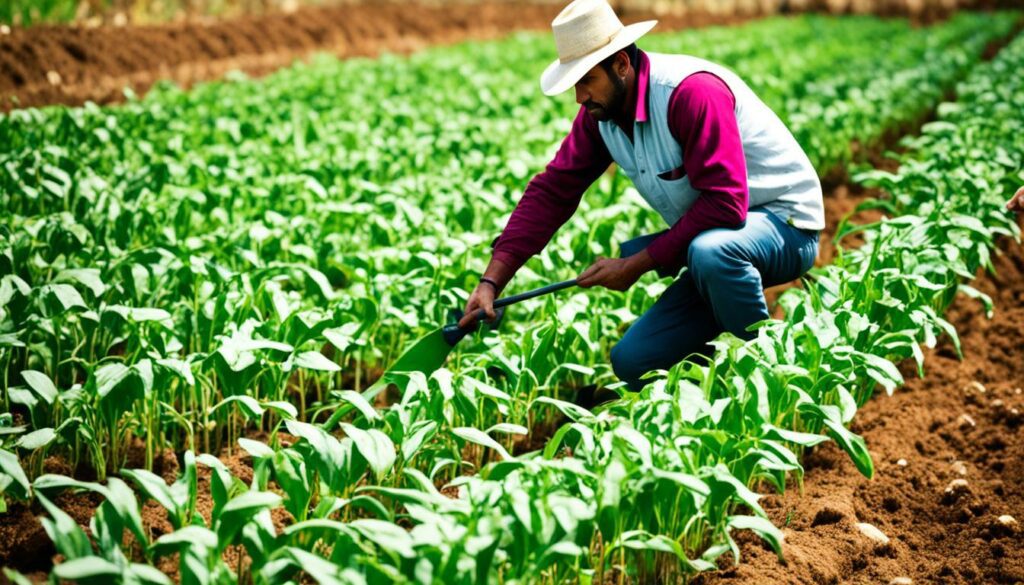
Making sure animals are healthy and well is very important. This includes investing in veterinary services and keeping an eye on animal health. In Vietnam, over 151,000 farmers have been helped. More than 23,000 of them have been trained to reduce their farms’ impact on the environment. This not only helps the animals but also cuts down on harmful emissions.
Locking away carbon in livestock systems is an important goal. The World Bank’s projects help make sure farms and pastures absorb more carbon, instead of letting it out. For example, in Argentina, managing pastures better has cut down around 3.4 million tons of CO2. In Colombia, using mixed tree and pasture systems has absorbed 1.05 million tons of CO2. This also helps protect different plant and animal species.
Over the past three years, 61% of the World Bank’s help for livestock has also been good for the climate. Projects like the Sahel Pastoralism Support are big, managing loads of pastureland in a smart way. This shows a full effort to tackle issues of sustainability and facing climate change.
The World Bank works hard to lower greenhouse gas emissions in the world’s agrifood system. This system currently causes one-third of global emissions. It is also a top source of methane and leads to loss in biodiversity. To make a real difference, cutting emissions here is crucial.
The Bank uses smart agricultural methods to fight these emissions. While farming leads to a lot of emissions, it only gets a small share of the funds to combat climate change. The Bank is putting more money into Climate-Smart Agriculture (CSA), up to nearly $3 billion a year. They’re funding projects all over the world, like in China and parts of Africa, to make farming more climate-friendly.
Watching how well these efforts work is very important. The Bank makes sure to check and share how much they are lowering emissions. For example, a project in Africa uses a detailed system to track emission cuts. The Bank also has to work in ways that match the Paris Agreement since July 2023. This is big for our global climate goals.
The World Bank focuses on smart investments and careful tracking to fight emissions worldwide.
The path to sustainable farming faces many obstacles. These need tackling for a successful switch. Agriculture produces about 30% of the planet’s greenhouse gases. With the world’s population aiming to reach 9 billion by 2050, we must increase our food output by 70%.
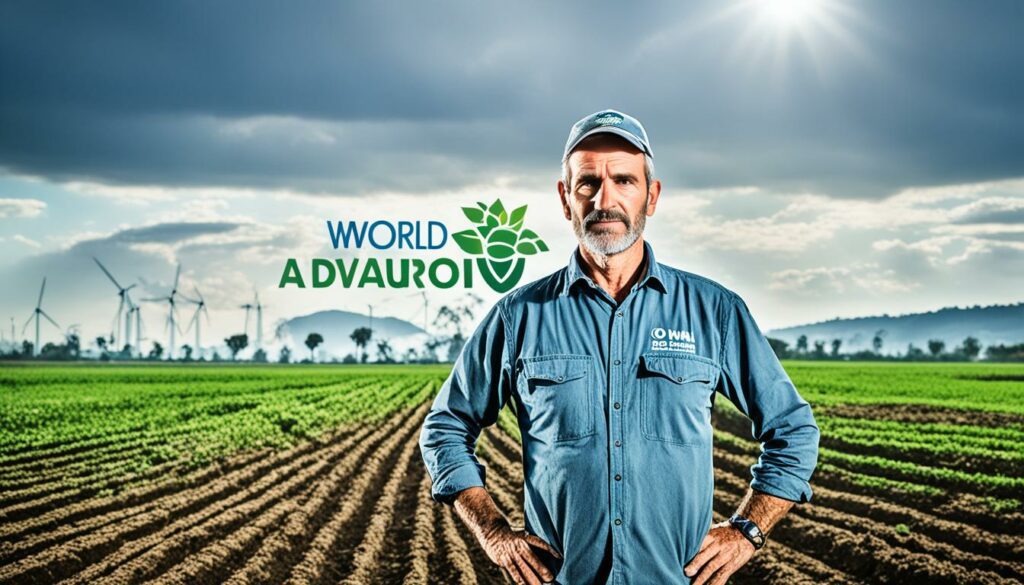
Big hurdles in farming include technical, financial, and political issues. The World Bank is tackling these problems head-on. It’s aiming to help farmers use newer methods and access modern tech like AI and drones.
Financial help is coming from loans and grants. These come from places like the National Institute of Food and Agriculture. They are focused on improving harvests and making food safer. Political roadblocks are being dealt with internationally. For example, 45 countries made promises at the 2021 UN Climate Change Conference to push green farming by 2030.
The future of farming aims for sustainability. World Bank projects target bettering the environment, soil health, and efficient resource use. They want to ensure farms stay profitable while also raising people’s quality of life. Using sustainable techniques like no-till farming and planting perennials can lessen farm harm.
It’s also crucial to cut down food waste. By 2030, it’s estimated we may waste 2.1 billion tonnes of food a year. The World Bank supports eco-friendly agriculture projects. These include helping with transport, processing, and market access. This not only helps farmers but also fits into wider environmental and developmental plans.
| Challenge | Details |
|---|---|
| Technical Barriers | Lack of modern farming technologies and practices like no-till farming, crop rotation, and AI utilization. |
| Financial Barriers | Inadequate funding and financial support for sustainable practices; loans and grants critical for solution. |
| Political Barriers | Regulatory challenges and need for international cooperation exemplified by initiatives like the UN Climate Change Conference pledges. |
| Environmental Impact | Mitigating the approximately 30% contribution of agriculture to global GHG emissions. |
The World Bank is a key player in making farming more sustainable. It focuses on ways that help the environment and support farmers. This includes making big investments and changing policies to help nature thrive.
It has made a big difference in many areas through various projects and partnerships. For example, a project in Benin brought better farming tech to over 300,000 farmers. In Bolivia, it worked with thousands of farmers to improve their methods.
In countries like Angola and Colombia, it helped with large investments to better farming and fight climate change. In the Central African Republic, the Bank’s efforts boosted local food production hugely.
It’s not just about the amount of food produced; the Bank also focused on improving the lives of farmers. In Cote d’Ivoire, 200,000 farmers saw better results, and thousands of rural roads were fixed, making life easier.
The World Bank’s work stretches from Africa to South America, showing a deep commitment. By supporting smart farming, it aims for a future where farming is both prosperous and good for the planet.
The World Bank helps farms become more sustainable. It does this by investing money, advising on policies, and launching projects like the Climate Change Action Plan. These actions aim to make farming more productive, resilient, and eco-friendly.
Sustainable farming rules ensure farming is profitable, eco-friendly, and respects communities. They guide how crops are grown, animals are cared for, and water is saved.
Sustainable farming tackles food security without making climate change worse. It uses methods that boost production, protect nature, and use water better.
The World Bank supports green farming with plans like the Climate Change Action Plan. It also creates reports on green farming in different countries and helps these places build eco-friendly farming policies. Its goal is to popularize sustainable practices.
In China and eastern Africa, the World Bank has helped create eco farming rules. This has cut down on harmful emissions, protected nature, and made the food system stronger.
Climate-Smart Agriculture uses methods that make farms more productive, climate-tough, and less polluting. It includes techniques like no-till farming, precise planting, and using crops that resist climate change.
Rules that lower methane in the air, manage water well, and stop the cutting down of forests are key for farms. They help farms go greener and last longer.
Agroforestry mixes crops with trees to make farms that are rich in life, efficient, and kind to nature. It helps plants grow better, dirt stay healthy, and traps carbon, meeting the goals of greener farming.
The World Bank helps poorer countries make their farms better and ready for tough times. It gives them new farm tech, trains farmers, and offers money support, especially to small farmers.
The World Bank gives cash to help farms be smarter about the climate. This money goes to new ideas, better tech, and greening national farm plans.
The World Bank helps make farm and food plans that stick to big eco promises like the Paris Agreement. This aid includes expert help, reports on what’s needed, and picks actions that do good for growth and cut polluting.
The World Bank backs ways to care for animals and cut down on farm gas. It puts money in vet help, watching for diseases, and making sure pastures help keep the air clean.
The World Bank pushes for farm methods that cut down air pollution, like careful manure use and precise planting. It also wants clear and fair ways to check and show how much gas farms make.
Top hurdles include tough tech, money issues, and politics slowing down rules. The World Bank works on these by offering big help, making sure countries can deal with problems and keep their green farm plans on track.